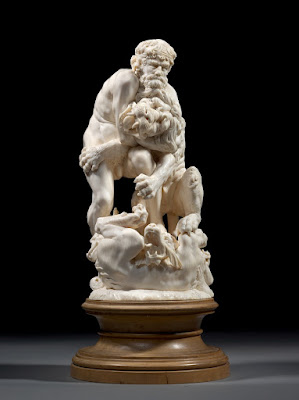 |
| Peter Paul Rubens Hippopotamus and Crocodile Hunt ca. 1615 oil on canvas Alte Pinakothek, Munich |
 |
| Paris Bordone Jupiter and Io ca. 1550 oil on canvas Göteborgs Konstmuseum, Sweden |
 |
| Lennart af Petersens Detail of ivory Salt Cellar made in Augsburg by Georg Petel 1948 gelatin silver print Moderna Museet, Stockholm |
 |
| Théodore Géricault Two Figures before 1824 drawing Musée Bonnat-Helleu, Bayonne |
 |
| Anonymous German Artist Hercules and the Nemean Lion ca. 1700 ivory Bode Museum, Berlin |
 |
| Anonymous German Artist St Margaret and the Dragon ca. 1400-1450 hand-colored woodcut Kupferstichkabinett, Staatliche Museen zu Berlin |
 |
| Gustaf Magnusson Decorative Cluster of Musical Instruments ca. 1920 tempera on paper Prins Eugens Waldemarsudde, Stockholm |
 |
| Braun, Clément & Cie. La Marseillaise ca. 1880 photogravure Moderna Museet, Stockholm |
 |
| Giulio Romano Taking of Christ before 1546 drawing Hamburger Kunsthalle |
-c1680-engraving-Hamburger-Kunsthalle.jpg) |
| Gérard Edelinck after Peter Paul Rubens The Battle of Anghiari (based on lost fresco cartoon of Leonardo da Vinci) ca. 1680 engraving Hamburger Kunsthalle |
 |
| Anonymous German Artist Job afflicted with Boils ca. 1480-1500 hand-colored woodcut Kupferstichkabinett, Staatliche Museen zu Berlin |
 |
| Anonymous German Artist Conversion of St Paul ca. 1550-1600 oil on copper Národní Galerie, Prague |
-Mus%C3%A9e-Carnavalet-Paris.jpg) |
| Jacques-Louis David Le Serment du Jeu de Paume ca. 1791-93 oil on canvas (unfinished) Musée Carnavalet, Paris |
 |
| Hans Baldung Hercules and Antaeus 1531 oil on panel Museumslandschaft Hessen Kassel |
 |
| Paul Jamin Abducting a Woman in the Stone Age 1888 oil on canvas Musée des Beaux-Arts de Reims |
 |
| Luca Giordano Youth Tempted by the Vices 1664 oil on canvas Städel Museum, Frankfurt |
Kalasiris paused for a moment until he had achieved the exalted state of mind appropriate to the contemplation of holy mysteries. Then he said: "Knemon, when gods and spirits descend to earth or ascend from earth, they very occasionally assume the form of an animal, but generally they take on human shape: the resemblance to ourselves makes their theophany more accessible to us. They might pass unperceived by the uninitiated, but they cannot avoid recognition by the wise, who will know them firstly by their eyes, which have an extraordinary intensity and never blink, but more especially by their method of locomotion, which is not accomplished by the displacement or transposition of their feet, but by a sort of smooth, gliding motion and without touching the ground, so that they cleave rather than walk through the circumambient air. This is why the Egyptians make their statues of the gods with the two feet connected and carved virtually as one form. Homer was well aware of this too, for he was an Egyptian and well versed in our holy lore. So he included enigmatic references to these phenomena in his epics, leaving their discovery to those who were capable of interpreting them. Thus of Athena he says, 'Her eyes were terribly shining,' and of Poseidon, 'I knew easily as he went away the form of his feet, the legs' form from behind him,' as if he is gliding along: that is the meaning of 'easily as he went away,' although some misconstrue the sentence and interpret 'I knew easily.'"
– Heliodorus, from The Aethiopica, or, Theagenes and Charikleia (3rd or 4th century AD), translated from Greek by J.R. Morgan (1989)